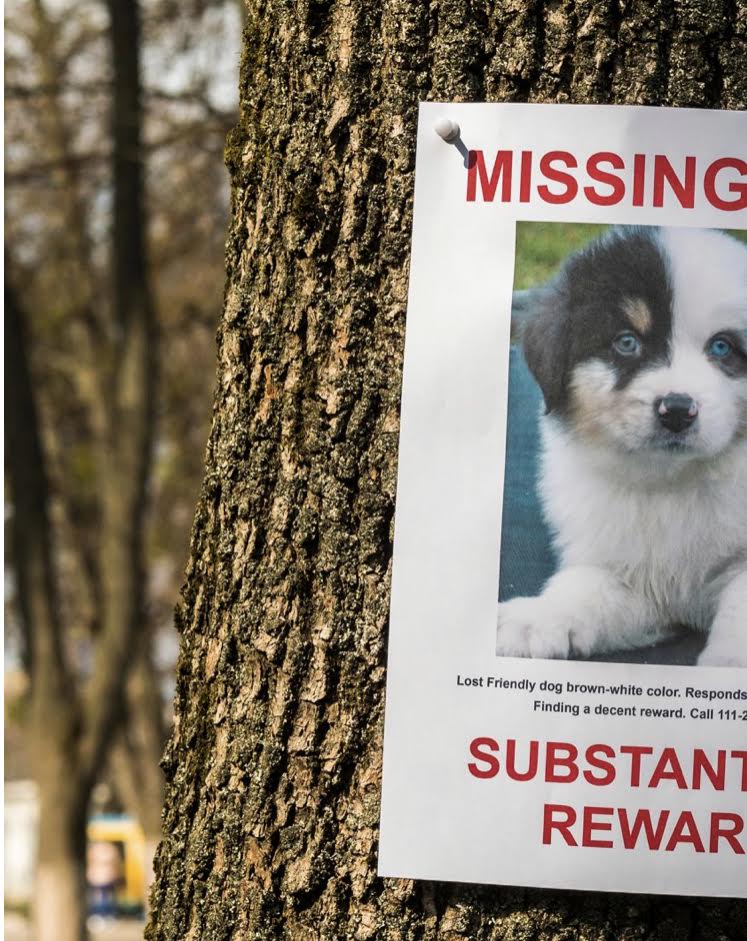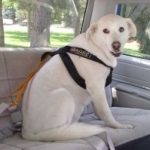
I recently read a wonderful book titled, Where the Lost Dogs Go, by Susannah Charlson. It is a chronicle of her mission to reunite lost pets with their families, including how she works with her own rescue dog who assists her in finding missing pets. In the book she studies animal behavior, lost-pet search tactics, social media strategies and the psychology of loss. Taken directly from her appendix, the following “lost pet checklist” is something I think incredibly important to share, and familiarize pet parents with, in hopes that you will never need it. Because there is so much information, I am splitting it into two posts.
All of us with pets should prepare before our pets go missing by doing the following:
1. Make sure your pet always wears a collar or harness with current contact info listed. Many modern collars come pre-printed with the info. Breakaway collars or harnesses are possible alternatives for those concerned about their pets getting snagged on trees or bushes by their collars.
2. Microchips with updated contact info. Tip: When you move homes, change the microchip and tag info the same day as when you change your address info at the post office.
3. Keep a snippet of your pet’s fur in a freezer bag for use by a search canine, as well as an old collar for scent. A seeled freezer bag will retain viable scent for 6 months.
4. Use a non-toxic ink pad to make paw prints of all 4 pads, or at least one. Searchers use it to compare prints in tracks.
5. Consider obtaining a GPS or radiofrequency device to attach to the collar. All pets that can or do get out should have microchips, which in my opinion means, all pets.
6. Familiarize with, and bookmark, lost pet websites on Facebook, and connect with neighborhood on Next Door.
7. Store quick sign making materials. A kit might include 5 full-sized pieces of neon pasteboard, 5 outdated campaign signs with stakes, packing tape, wide nabbed black permanent markers.
8. Keep 2-3 current pictures of your pet, including at least 1 whole body shot and a face shot against a plain background. Busy backgrounds are harder to see in a moving vehicle. Store at lease one copy of vet records and a photo of your pet to prove you are the owner/pet guardian, as some savvy pet finders are sometimes wary to give up a dog to just anyone.
IF YOUR PET GOES MISSING:
When possible, divide the following search tasks with friends or family.
Create Awareness
1. Make a visual canvas of where the pet was lost. Talk to neighbors, passersby and connect with those walking their own dogs. Excellent resources are mail carriers, deliver drivers and utility workers. They go on the same routes 1-2 times daily. If ongoing construction is in the area, ask crew members to keep an eye out.
2. Build, copy and post signs in neighborhood and one buildings, especially vet clinics, pet supply stores, groomers, gas stations, supermarkets and convenience stores.
-Post one below your own mailbox. Some HOAs restrict where you can post or how long.
-Place signs on parked car windows. Ask neighbors to post signs in their yards and enlist volunteers to hold signs at intersections.
3. Post on social media, especially Facebook (lost pet pages) and Next Door (select widest posting area possible).
-Email list distribution on platforms like “helping lost pets”, “Pawboost”, etc. Some are free, while others charge a fee.
-Make sure to have notifications pushed to your email or phone if possible.
-Check resources at least 1-2 times a day, and monitor your post and also that of others who found a pet and posted. Often people who have found a pet will post without necessarily checking for a post about almost pet that matches.
4. Canvas the area by foot or vehicle repeatedly with flyers at different times. You are more likely to meet new people on different trips. Handing out flyers and personal interaction will help people become invested in your search and want to help.
5. Make sure your local signage is easy to read, weatherproof, and includes a prompt method of contact. A phone number or email that can be answered easily and reliably, day or night, is best.

TIPS for lost pet signs can be found on great resources:
www.missinganimalresponse.com and
www.missionreunite.org
6. Notify your microchip company that pet is lost or stolen. A flag will be put on your pet’s record so any finder is aware that a pet is lost and an owner is actively searching for it.
7. Remind others – on signs and in conversations – NOT to call or chase your lost pet. Anxious animals process strangers or even their owners – differently. Calling or chasing a pet can push them back into flight mode.
8. Tag your vehicle with wide tipped markers made for writing on glass, and put critical information on the back window. www.missinganimalresponse.com has excellent tips for car tagging.
Search Strategies:
1. Consider the use of a canine lost pet search service promptly; within 24 hours is advantageous, although sometimes is helpful even longer after your pet goes missing. These canines are trained, but a fresh scent is optimal to help them track and trail more easily. With area searches, where an animal may be injured or trapped, time is critical.
2. Check area shelters, beginning with the closest shelters to where your pet was last seen. Make a physical check every 2 or 3 days, and when possible, provide info about your missing pet to staff. Working outward from the area where your pet was lost, make incrementally larger circles. Sometimes drivers or truckers may leave a pet they have found at a shelter near where they are going, instead of where they found them. Keep in mind that a pert may wander quite a while before put into a shelter. Thus, shelter checks should remain for the duration of the search.
3. If you receive sighting info suggesting someone saw your pet near wilderness, work with a lost pet consultant or humane trapping specialist to set up a feeding station, wildlife camera, and a humane trap in the area. This is thoughtful, strategic business that requires expertise. Many strategists offer consulting services by phone or online. Again, www.Missinganimalresponse.com offers a state by state list of people who can help.

Stay tuned for the second part of this vital info in the next post.
Dr. Dawn



